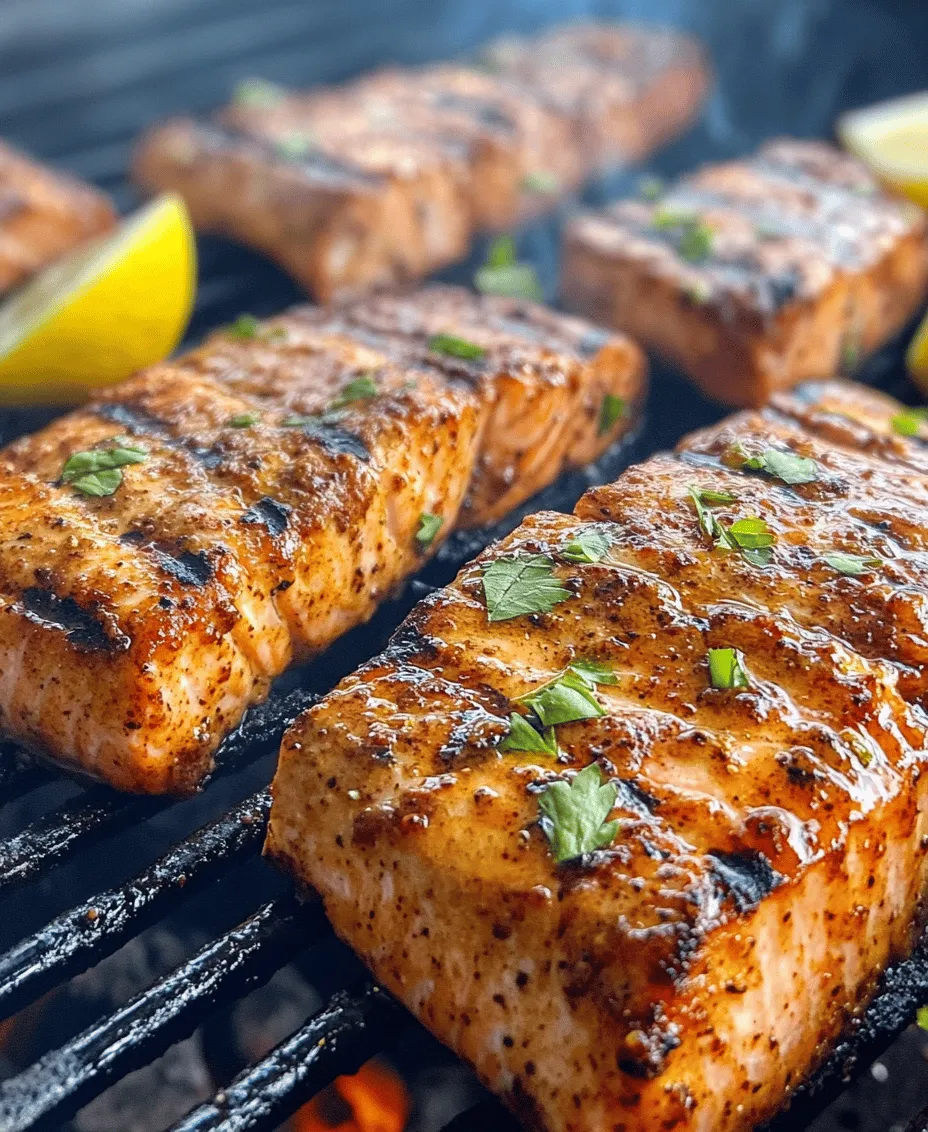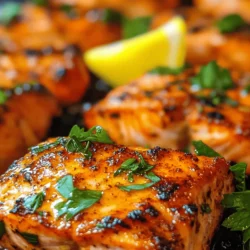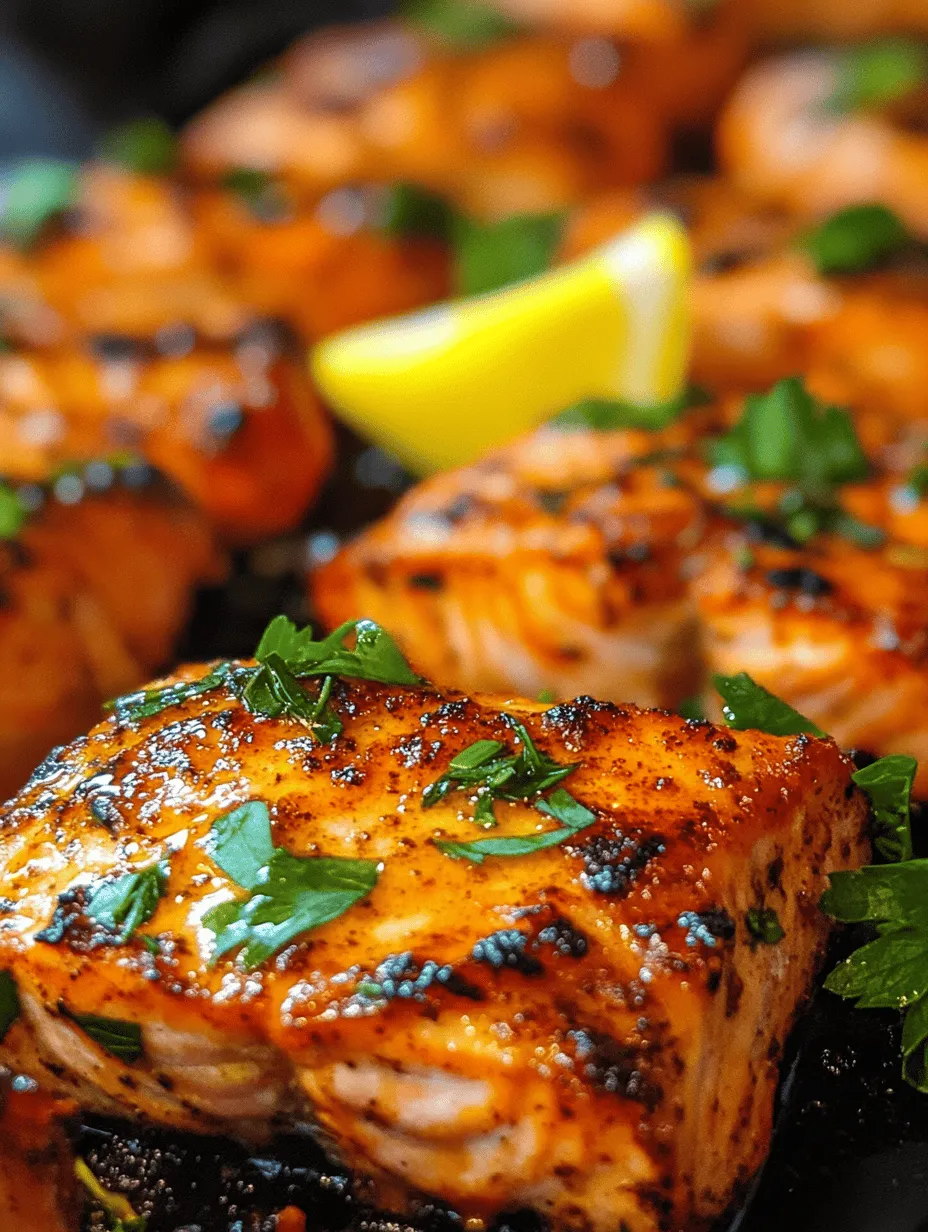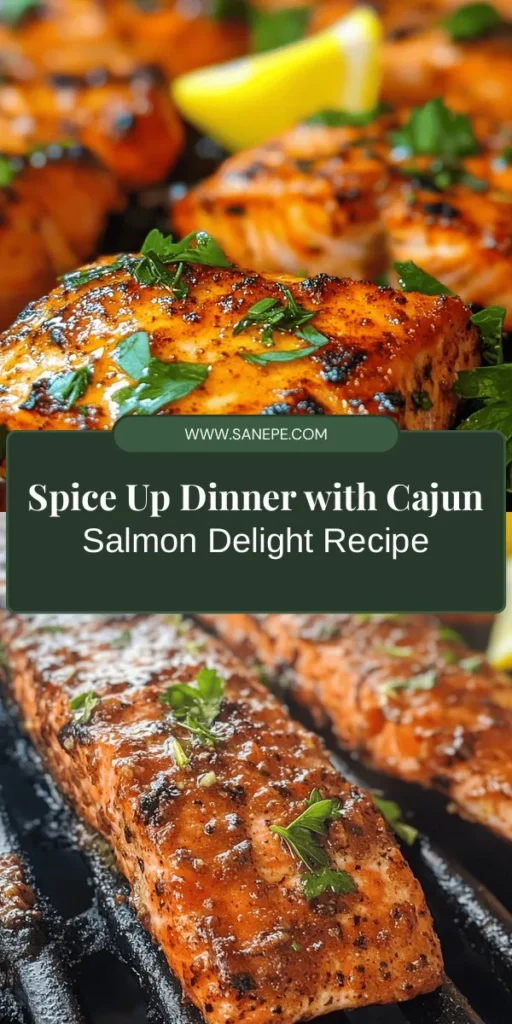Introduction
If you’re seeking a dish that tantalizes your taste buds and offers a burst of rich, vibrant flavors, look no further than Spicy Cajun Salmon Delight. This dish is not only a feast for the senses but also a celebration of the bold and zesty characteristics of Cajun cuisine. With its origins steeped in rich cultural traditions, Cajun cooking is renowned for its ability to balance spices, herbs, and fresh ingredients, creating dishes that are both hearty and healthful.
Cajun cuisine is all about harmony—where each ingredient plays a crucial role in crafting a well-rounded flavor profile. The Spicy Cajun Salmon Delight embodies this principle, featuring succulent salmon fillets coated in a homemade Cajun seasoning that brings out the best in this fish. In addition to its mouthwatering taste, this dish offers an array of health benefits, making it an ideal choice for those looking to maintain a balanced diet.
Salmon is not only delicious but is also loaded with essential nutrients. It’s a fantastic source of omega-3 fatty acids, which are known to promote heart health, reduce inflammation, and potentially lower the risk of chronic diseases. Paired with the bold flavors of Cajun spices, this dish not only delights the palate but also nourishes the body.
Understanding Cajun Cuisine
To truly appreciate the Spicy Cajun Salmon Delight, it’s essential to understand the roots of Cajun cuisine. Originating from the Acadian people who settled in Louisiana, Cajun cooking is a melting pot of flavors influenced by French, African, Spanish, and Native American culinary traditions. This rich history of cultural blending is reflected in the dishes that define Cajun cooking today.
At the heart of Cajun cuisine is the use of fresh, locally sourced ingredients. Common staples include rice, beans, seafood, and a variety of meats, which are often seasoned with a blend of spices. Key ingredients such as cayenne pepper, paprika, garlic, and onion form the backbone of many Cajun dishes, providing the distinctive heat and flavor that Cajun cooking is known for.
The cultural significance of these flavors cannot be overstated. Cajun cooking is often described as a celebration of life, where food brings people together. Dishes are typically hearty, designed to feed a crowd, and are often enjoyed during gatherings and festivals. Cajun seasoning, in particular, plays a vital role in enhancing the taste of seafood. The combination of spices elevates the natural flavors of fish, making it a favorite among seafood lovers.
Ingredients Breakdown
Salmon Fillets
The star of our dish is undoubtedly the salmon. Rich in omega-3 fatty acids, protein, and essential vitamins, salmon is a nutritional powerhouse. It provides a wealth of health benefits, including improved brain function, heart health, and reduced inflammation. When selecting salmon for this recipe, look for fresh, sustainably sourced fillets that are firm to the touch and have a vibrant color.
Cajun Seasoning
Cajun seasoning is a blend of spices that captures the essence of Cajun cuisine. Typically composed of paprika, cayenne pepper, garlic powder, onion powder, thyme, oregano, and black pepper, this spice mix offers a perfect balance of heat and depth of flavor. The smokiness of paprika combined with the heat of cayenne makes it an ideal accompaniment to seafood, enhancing the natural flavors of the fish while adding a delightful kick.
Olive Oil
In our recipe, olive oil serves multiple purposes. It acts as a cooking medium, helping to achieve a perfect sear on the salmon while adding a layer of richness to the dish. Olive oil is also known for its health benefits, including heart-healthy monounsaturated fats and antioxidants. Using high-quality extra virgin olive oil can enhance the overall flavor of the dish.
Garlic
Garlic is a staple in many cuisines, and Cajun cooking is no exception. It adds a robust flavor and aroma to the marinade, contributing to the dish’s overall depth. Beyond its culinary uses, garlic is also known for its health benefits, including antimicrobial properties and potential heart health benefits.
Lemon Juice
A splash of lemon juice not only brightens the flavors of the Spicy Cajun Salmon Delight but also adds a refreshing tang that balances the richness of the fish and the heat of the spices. The acidity of lemon juice helps to tenderize the salmon while enhancing its natural flavors.
Smoked Paprika
Smoked paprika is a key player in this dish, providing a unique smokiness that complements the Cajun seasoning. Its rich, slightly sweet flavor adds depth to the marinade and pairs beautifully with the salmon. Smoked paprika is an essential ingredient in many Cajun recipes, contributing to the overall flavor profile.
Suggestions for Ingredient Substitutions
While the ingredients listed are ideal for achieving the best flavor in this dish, there are options for substitutions if needed. For instance, if salmon is unavailable, you can substitute with other fish like tilapia or trout. For those who prefer a milder flavor, reducing the amount of cayenne pepper in the Cajun seasoning can help tone down the heat. Olive oil can be replaced with avocado oil for a similar taste and health benefits, while fresh garlic can be substituted with garlic powder in a pinch.
Preparing the Marinade
Creating a marinade is one of the most crucial steps in preparing the Spicy Cajun Salmon Delight. A well-balanced marinade enhances the flavor of the fish while ensuring it remains moist and tender during cooking. Here’s how to make the marinade:
1. Gather Your Ingredients: Start by assembling all the necessary ingredients, including olive oil, garlic, Cajun seasoning, lemon juice, and smoked paprika.
2. Mix the Ingredients: In a medium-sized bowl, combine the olive oil, minced garlic, Cajun seasoning, lemon juice, and smoked paprika. Whisk them together until well blended, ensuring that the spices dissolve into the liquid.
3. Taste and Adjust: Before marinating the salmon, taste the marinade. If you prefer more heat, add a pinch of cayenne pepper. If you like it tangy, increase the lemon juice. The goal is to achieve a well-rounded flavor that complements the salmon.
4. Marinating the Salmon: Place the salmon fillets in a shallow dish or resealable plastic bag and pour the marinade over them. Ensure that the fish is evenly coated on all sides.
5. Let It Sit: For the best flavor, let the salmon marinate for at least 30 minutes at room temperature. If you have more time, consider marinating it in the refrigerator for up to an hour. This allows the flavors to penetrate the fish, resulting in a more flavorful dish.
Importance of Marinating in Flavor Development
Marinating is a critical step in cooking that not only adds flavor but also helps to tenderize the meat. The acids in the marinade, such as lemon juice, break down the protein in the fish, making it more tender and juicy. Additionally, marinating allows the spices and flavors to infuse into the salmon, creating a deliciously seasoned dish that is bursting with flavor.
Tips for Achieving the Perfect Balance of Spices in the Marinade
– Start with Less Spice: If you’re unsure about your spice tolerance, start with a smaller amount of Cajun seasoning and gradually increase it to your liking.
– Use Fresh Ingredients: Fresh garlic and quality olive oil make a significant difference in flavor. Whenever possible, opt for fresh ingredients for the best results.
– Let It Marinate Longer: If time permits, allowing the salmon to marinate longer will enhance the flavor even more. Just be cautious not to marinate for too long, as it could affect the texture of the fish.
Marinating the Salmon
Once your marinade is ready, it’s time to marinate the salmon properly. Here are some best practices to ensure that your salmon absorbs all the delightful flavors:
1. Choose the Right Container: Use a shallow dish or a resealable plastic bag for marinating. This allows for maximum surface area exposure and ensures the salmon is evenly coated.
2. Coat Evenly: When placing the salmon in the marinade, make sure each fillet is coated evenly. Use a spoon to pour the marinade over the fish and gently massage it in.
3. Refrigerate if Necessary: If you are marinating for longer than 30 minutes, it’s advisable to refrigerate the salmon to keep it fresh and safe from bacteria.
4. Turn Occasionally: If marinating in a dish, turn the salmon fillets halfway through the marinating time to ensure all sides absorb the flavors.
5. Discard Used Marinade: After marinating, discard any leftover marinade that has come into contact with the raw fish to prevent cross-contamination.
By following these steps, you’ll ensure that your Spicy Cajun Salmon Delight is packed with flavor and ready to impress at the dinner table. Remember, the marinating process is where the magic happens, transforming simple salmon fillets into a dish that’s anything but ordinary. Stay tuned for the next section where we will delve into the cooking process and additional tips to perfect this delightful recipe.

Marination Time Impact on Flavor
The marination process is crucial when it comes to enhancing the flavor of your Spicy Cajun Salmon Delight. The longer you allow the salmon to marinate, the more pronounced the spices and seasonings will become, resulting in a more flavorful dish. Ideally, marinating for at least 30 minutes is recommended, but for optimal flavor, aim for 2 to 4 hours. If time permits, marinating overnight will allow the Cajun spices to penetrate deeply into the fish, creating a robust taste that is hard to resist.
When marinating, it’s essential to use the right kind of container. Glass or ceramic bowls are ideal because they do not react with the acidic components of the marinade. Avoid using metal containers, as they can impart unwanted flavors and react with acidic ingredients. If you’re in a pinch, resealable plastic bags can also be effective, allowing for easy coverage and minimal cleanup.
Cooking Techniques
When it comes to cooking your Cajun salmon, there are two primary methods to consider: grilling and pan-searing. Each method has its unique benefits, and the choice often comes down to personal preference.
Grilling vs. Pan-Searing Salmon
Grilling: This method infuses the salmon with a smoky flavor that complements the spicy Cajun seasoning beautifully. Grilling also allows excess fat to drip off, resulting in a lighter meal. It’s perfect for outdoor cooking and provides an excellent char that many find appealing.
Pan-Searing: This technique is more accessible for those who might not have access to a grill. Pan-searing allows for precise control over cooking temperature and time, giving you a beautifully caramelized crust while keeping the interior moist.
Preheating the Grill or Pan
Regardless of the method you choose, preheating is essential. For grilling, preheat your grill to medium-high heat, generally around 375°F to 400°F. This ensures that the salmon gets that perfect sear. If you’re pan-searing, heat a tablespoon of olive oil in a non-stick skillet over medium-high heat until it shimmers, indicating that it’s hot enough to start cooking.
Tips for Cooking Salmon
To ensure your salmon is cooked perfectly, follow these essential tips:
1. Pat the Salmon Dry: Before cooking, use a paper towel to pat the salmon dry. This step helps achieve a crispier exterior.
2. Oil the Grill or Pan: Lightly oil the grill grates or the pan to prevent sticking. This is especially important for salmon, which can easily fall apart.
3. Cook Skin-Side Down: If your salmon has skin, place it skin-side down first. This will help protect the flesh from direct heat and keep it moist.
4. Monitor Cooking Time: Salmon generally takes about 4-6 minutes per side, depending on thickness. A good rule of thumb is to cook it for about 8-10 minutes total for every inch of thickness.
Understanding Doneness
Knowing when your salmon is perfectly cooked is key. Salmon is done when it flakes easily with a fork and has an internal temperature of 145°F. You can also check for doneness by pressing down on the top of the fillet with a fork; if it flakes easily, it’s ready to eat. However, be cautious not to overcook it, as this can lead to a dry texture.
Plating and Presentation
Presentation plays a significant role in the culinary experience. A well-plated dish not only stimulates the appetite but also enhances the overall enjoyment of the meal. When serving your Spicy Cajun Salmon Delight, consider the following tips for an appealing presentation:
1. Garnishing: Fresh chopped parsley adds a pop of color and freshness. Sprinkle it generously over the salmon just before serving. Additionally, serve lemon wedges on the side. The citrus not only elevates the dish with a zesty flavor but also adds vibrant color to your plate.
2. Complementary Side Dishes: To round out the meal, consider pairing your salmon with sides that complement its bold flavors. Grilled asparagus, roasted sweet potatoes, or a fresh green salad with a light vinaigrette are excellent choices. The sweetness of the sweet potatoes balances the spiciness of the salmon, while the salad provides a refreshing contrast.
3. Creating an Appealing Dining Experience: Pay attention to the overall dining experience by setting a beautiful table. Use colorful plates, carefully arrange your salmon and sides, and add decorative elements like candles or flowers. This sets the stage for an enjoyable meal.
Nutritional Information
Understanding the nutritional value of your meal is essential for maintaining a balanced diet. Each serving of Spicy Cajun Salmon Delight offers impressive health benefits:
– Calories: Approximately 350 calories
– Protein: 30 grams
– Fat: 20 grams (with healthy omega-3 fatty acids)
– Carbohydrates: 5 grams
– Fiber: 1 gram
Salmon is an excellent source of high-quality protein and is rich in essential omega-3 fatty acids, which are known to support heart health. These healthy fats can help reduce inflammation and are beneficial for brain function. Including salmon in your diet can be a delicious way to enhance your overall health, making it a wise choice for regular meals.
Variations and Customizations
One of the best aspects of cooking is the ability to customize recipes to suit your tastes. Here are some ideas for variations and customizations to your Spicy Cajun Salmon Delight:
1. Alternative Spices and Flavors: If you’re looking to experiment, consider adding different spices to your Cajun seasoning. Smoked paprika, cayenne pepper, or even a hint of brown sugar can alter the flavor profile and add a unique twist.
2. Adjusting Spice Levels: For those who prefer a milder flavor, reduce the cayenne pepper or opt for a milder Cajun seasoning blend. Conversely, for those who crave heat, add extra cayenne or a splash of hot sauce to the marinade or as a finishing drizzle.
3. Pairing with Various Side Dishes and Sauces: The Spicy Cajun Salmon can be paired with a variety of sides, including quinoa, rice pilaf, or even creamy grits. Consider serving it with a tangy remoulade or a cooling yogurt sauce to balance the spice and add an extra layer of flavor.
Conclusion
In conclusion, Spicy Cajun Salmon Delight is a wonderful dish that combines rich flavors, health benefits, and versatility. The careful balance of spices, along with the freshness of the salmon, creates a meal that is both satisfying and delicious. By marinating the salmon properly, choosing the right cooking technique, and presenting it beautifully, you can elevate this dish to new heights.
Cajun cuisine brings a vibrant and exciting element to home cooking, encouraging you to explore bold flavors and share delightful meals with loved ones. Embrace the joy of cooking, experiment with different spices and sides, and make this dish your own. Whether it’s a weeknight dinner or a special gathering, Spicy Cajun Salmon Delight is sure to impress everyone at the table. Enjoy the process, savor the flavors, and most importantly, share the experience with those you care about.


